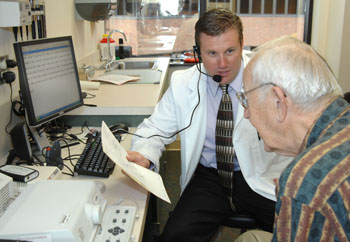
William Dickinson, Au.D., uses a voice recognition software program to better communicate with patient Tom Yount. (photo by Neil Brake)
Software eases communication for hearing-impaired patients
Creative clinicians at Vanderbilt Medical Center are turning a tool intended to streamline hours of costly chart dictation into an effective new way to communicate with hearing-impaired patients.
The Dragon Naturally Speaking voice recognition software program can transcribe dictation up to three times faster than an average person can type, and has been adopted by several VMC clinics as a tool to lower transcription fees.
However, several clinicians have found that the software helps them communicate more effectively with hearing-impaired and deaf patients.
“The first time it occurred to me to use Dragon this way was with an elderly patient who is very hard of hearing,” said William Serafin, M.D., assistant professor of Clinical Medicine. “Typically, his daughter would accompany him on clinic visits but this time it wasn't possible. So I decided to do transcription right in front of the patient and it worked quite well.”
Serafin said that with hearing-impaired patients clinicians are always concerned about the accuracy of information patients take away from the encounter.
“Most of our patients are nice people who are accommodating and want to please their doctor. This means, especially for our hearing-impaired patients, they may be nodding their heads ‘yes’ while not comprehending what is said,” Serafin said.
Dragon Speak Naturally interprets the speaker's dictation and can almost instantly display the spoken word onto a computer monitor. Not only can users enlarge the size of the type font on the computer's display for patients who also may have vision problems, they can also print a copy of what was just dictated for patients to take away.
“The advantage for the patient is not only can they read and confirm what was said, but receiving a printout also allows them to reconstruct my half of the conversation,” Serafin said. “I know that frequently patients experience information overload during an office visit. Using Dragon requires an extra step, but it's very helpful. For patients with significant hearing loss this can make a substantial difference.”
According to William Dickinson, Au.D., assistant professor of Hearing and Speech Sciences in the Bill Wilkerson Center, there are approximately 30 million Americans who are hearing impaired, with as many as 67 percent of these individuals younger than age 65. About 500,000 Americans suffer from severe to profound hearing loss. The Bill Wilkerson Center sees more than 20,000 patients each year with hearing, communication and balance disorders.
“By using speech recognition software with our patients it's almost the same effect for them as watching closed-caption text on TV, where they watch our faces and also have words appear on the screen,” said Dickinson. “The information can be stored, or the patient can receive an immediate packet about the care plan to take home and share with family.”
Since hearing loss is often associated with aging, Dickinson's clinic sees a high volume of patients who also have memory difficulties. “For these patients who cannot have someone accompany them to clinic they might go home with mixed messages without the printed materials,” he said. “The printed dictation also creates a record of the discussion for the clinician.”













